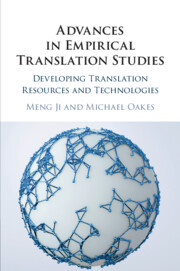Book contents
- Advances in Empirical Translation Studies
- Advances in Empirical Translation Studies
- Copyright page
- Contents
- Figures
- Tables
- Contributors
- Preface
- 1 Advances in Empirical Translation Studies
- 2 Development of Empirical Multilingual Analytical Instruments
- 3 Statistics for Corpus-Based and Corpus-Driven Approaches to Empirical Translation Studies
- 4 The Evolving Treatment of Semantics in Machine Translation
- 5 Translating and Disseminating World Health Organization Drinking-Water-Quality Guidelines in Japan
- 6 Developing Multilingual Automatic Semantic Annotation Systems
- 7 Leveraging Large Corpora for Translation Using Sketch Engine
- 8 Developing Computerised Health Translation Readability Evaluation Tools
- 9 Reordering Techniques in Japanese and English Machine Translation
- 10 Audiovisual Translation in Mercurial Mediascapes
- 11 Exploiting Data-Driven Hybrid Approaches to Translation in the EXPERT Project
- 12 Advances in Speech-to-Speech Translation Technologies
- 13 Challenges and Opportunities of Empirical Translation Studies
- Index
- References
5 - Translating and Disseminating World Health Organization Drinking-Water-Quality Guidelines in Japan
Published online by Cambridge University Press: 10 June 2019
- Advances in Empirical Translation Studies
- Advances in Empirical Translation Studies
- Copyright page
- Contents
- Figures
- Tables
- Contributors
- Preface
- 1 Advances in Empirical Translation Studies
- 2 Development of Empirical Multilingual Analytical Instruments
- 3 Statistics for Corpus-Based and Corpus-Driven Approaches to Empirical Translation Studies
- 4 The Evolving Treatment of Semantics in Machine Translation
- 5 Translating and Disseminating World Health Organization Drinking-Water-Quality Guidelines in Japan
- 6 Developing Multilingual Automatic Semantic Annotation Systems
- 7 Leveraging Large Corpora for Translation Using Sketch Engine
- 8 Developing Computerised Health Translation Readability Evaluation Tools
- 9 Reordering Techniques in Japanese and English Machine Translation
- 10 Audiovisual Translation in Mercurial Mediascapes
- 11 Exploiting Data-Driven Hybrid Approaches to Translation in the EXPERT Project
- 12 Advances in Speech-to-Speech Translation Technologies
- 13 Challenges and Opportunities of Empirical Translation Studies
- Index
- References
Summary
This chapter offers an original study of the translation and circulation of the World Health Organisation Drinking Water Quality Guidelines (DWQG) (Third Edition) first published in 2004 by the Japanese Water Works Association. The translation of the principles and the suggestions put forward by authoritative, international health organisations in national contexts requires not only high quality translations, but also relies on the existence of an effective society-wide transmission network able to link together the main sources of information: governmental agencies, industrial and business sources, on the one hand, and the end users of the information distributed, on the other, that is, a wide range of industrial sectors associated with water. Using quantitative corpus linguistic methods and political discourse analysis frameworks, this study identifies and constructs a formalised empirical model of the social dissemination and adaptation of translated international drinking water health guidelines in Japan. This study illustrates, through the use of structural equation modelling, firstly, the main sources of information in Japan that drive and facilitate the distribution of translated health concepts, standards and regulatory approaches originally suggested in the WHO document; secondly, the mediating effect of the mass media, especially newspapers and magazines, on the transmission of translated information to industrial sectors; and thirdly, the differences in the attribution by direct and mediating sources of information of social accountability among industrial sectors in regard to the materialisation of four key aspects of the WHO drinking water quality guidelines: targets, standards, approaches, and actions.
Keywords
- Type
- Chapter
- Information
- Advances in Empirical Translation StudiesDeveloping Translation Resources and Technologies, pp. 77 - 93Publisher: Cambridge University PressPrint publication year: 2019

